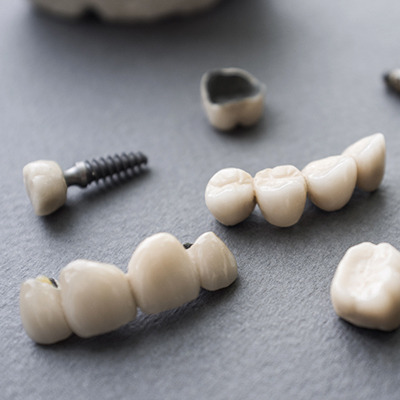10 Jul Dental Crowns: When Do You Need Them?

The tooth-shaped cap that’s placed over a tooth to restore its shape, size, and strength is called a dental crown. Once cemented in place, dental crowns will fully encase the entire visible portion of the tooth.
When do you need dental crowns?
Dental crowns may be recommended in the following scenarios:
- When a weak tooth needs protection so it does not break apart
- When a broken or severely worn down tooth needs to be restored
- When a tooth with a large filling needs to be covered and supported
- When a dental bridge needs to be held in place
- When a severely discoloured or misshapen teeth needs to be covered
- When a dental implant needs to be covered
What are the different types of dental crowns available?
Permanent dental crowns can be made from all metal (i.e. gold or another alloy), stainless steel, all resin, porcelain-fused-to-metal, or all ceramic.
Stainless steel
Stainless steel crowns are prefabricated crowns used on permanent teeth as temporary measure. The crown will protect the tooth or filling while a permanent crown is being made. In children, a stainless steel crown is typically used to fit over the primary tooth to protect it from further decay.
Once the primary tooth comes out, the crown will come out with it naturally. Generally, stainless steel crowns are used for children’s teeth since they are cost-effective and won’t require multiple dental visits.
Porcelain-fused-to-metal
Unlike metallic crowns, porcelain-fused-to-metal dental crowns can be colour matched to mimic the patient’s adjacent teeth. However, more wearing is likely to occur to the opposing teeth with this type of crown compared to resin or metallic crowns.
The porcelain portion of the crown can also break off or chip easily. In some cases, the metal thats underlying the crown porcelain can also appear as a dark line. This is especially true when the gums recede. However, porcelain-fused-to-metal crown are considered a good choice for the back or front teeth as well as long bridges where metal can provide the much-needed strength.
Metals
Metals that are used in crown alloys have a high content of platinum or gold or base-metal alloys like cobalt chromium or nickel-chromium alloys. Metal crowns can also withstand chewing and biting forces very well and can last for a really long time. Its main drawback is its metallic colour. However, metal crowns are considered a great choice for out-of-sight molars.
All-resin
All-resin dental crowns cost less compared to other crown types. However, they can wear down over time. In addition, they are also more prone to fractures than porcelain-fused-to-metal crowns.
All-porcelain or all-ceramic
All-ceramic or all-porcelain dental crowns are known to provide a better natural colour match compared to other crown types. They are also considered a more suitable option for people with metal allergies. All-ceramic or all-porcelain crowns can also be used for both the back and the front teeth
Temporary versus permanent
Temporary crowns can be made in the dentist’s office while permanent ones are made in a dental laboratory. Typically, temporary dental crowns are made of acrylic-based materials or stainless steel. They are often used as temporary restorations until a permanent dental crown has been created in the dental lab.




